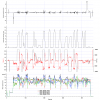@sar104 ——Would you be willing to do the test on a set of the new carbon fiber props for the MM? If so, I’ll have a set sent to you from China.
Sure - if I can get some I'll test them. I wasn't aware that any were yet available.
@sar104 ——Would you be willing to do the test on a set of the new carbon fiber props for the MM? If so, I’ll have a set sent to you from China.
Hi Sar,
First thank you for all of the experiments and great insight. This is the first time I've seen data based evidence to determine what is happening with the UD's. Which program are you using to produce those charts?
Randy
Thank you! I really appreciate the quick response.
Hi SAR - thanks for your interesting work and patience with all of us.
So knowing what you know now, do you plan to make any changes to your own MM (eg hunt down aftermarket carbon fibre props)? Or will you just try to be careful not to distort the props when it’s stored?
Dave
I always before each flight twist each prop about 45° to give it more lift.The prop positioning infographic in the Flymore case is a bit misleading too. It shows the blades of the port side rear props overlapped in a way they don’t go (see pics). View attachment 100294View attachment 100295
I always before each flight twist each prop about 45° to give it more lift.
Dont know if it works but never had any problems regarding decent or motors. On the prop pictures it looks as if the bottom one has negative lift at the tip.
Regarding the prop folding into the case mine works 100% according to the prop positioning infographic.
Sorry yes the top oneIf you mean in the image that I posted, the top one is the one lacking lift at the tip - it almost has a negative angle of attack.
Here is a view that shows quite clearly the deformation that is occurring:
View attachment 100293
The top propeller is from the rear left motor, and was on the aircraft for the flights depicted in the earlier graphs. The bottom propeller is brand new, unused. As you can see the profile starts of very similar, but towards the tip of the prop the old one is clearly twisted, CCW as viewed from the end. That is going to result in significantly less (if any) lift generated over the outer ½ to ⅓ of the length.
Very interesting. So when people describe the prop problem is due to "flattening from improper storage" in reality the props are being twisted and not flattened, correct?

We use essential cookies to make this site work, and optional cookies to enhance your experience.


